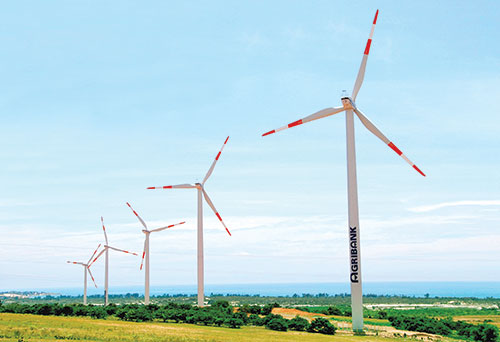
Tuy Phong Wind Power (Binh Thuan province). Illustrated photo
VCCI proposed the Government to push up the appraisal and approval of supplementary plan of wind power to promptly implement under Decision No. 39/2018/QD-TTg (on mechanism to support the development of wind power projects in Vietnam). It is considered extending the duration of implementing Decision No. 39 to the end of 31 December 2023 as many projects are behind schedule on prolonged site clearance and planning procedures and wind turbine suppliers from Europe are ceasing their production.
Under Decision No. 39/QD-TTg dated 10 September 2018, by the Prime Minister, for in-land wind power, the purchase price at the delivery point is VND 1,927/kWh, equivalent to 8.5 Uscents/kWh (excluding VAT); for offshore wind power, the price at delivery point is VND 2,223/kWh, equivalent to 9.8 Uscent/kWh (excluding VAT). The price is applicable to wind powers with a part of or the whole plants whose commercial operation date is before 1 November 2021 and within 20 years from commercial operation date.
The Decision has created a driving force for the development of wind power market in Vietnam. Hundreds of projects have been proposed to the supplementary planning; many projects are being constructed. However, up to now, there are 11 projects put into operation with the total capacity of 377MW.
The reason is that upon the effective date of Decision No. 39 (1 November 2018), investment registration and supplementary planning activities for new wind power projects and transmission grid projects releasing capacity have been delayed for more than a year due to no guidance on the implementation of the Planning Law (effective date from 1 January 2019). There are still 45,000MW of wind power (250 projects) proposed by the provinces that have not been appraised and supplemented on the planning.
Along with that, the complicated COVID-19 pandemic across the world has affected the progress of turbine supply, prolonged construction, installation and delayed the wind powers projects progress; production and supply activities of main equipment, components of the projects have become insufficient or stagnated; the immigration of foreign technical workers and experts is interrupted, etc.
According to the report submitted to the Prime Minister, VCCI suggested the State Bank of Vietnam (SBV) should instruct commercial banks to allow enterprises to invest in the energy sector, including reduction in the requirements of equity capital when borrowing capital (from 30% - 40% to 15% - 20%) to invest in this sector, especially in wind power and solar power to serve energy security.
VCCI suggested that the SBV take stronger measures to encourage commercial banks to make further reduction of 2-3% for new and existing loans (around 4-5% for VND loan and 2-3% for USD-dominated loan) for each group of customers affected by the Covid-19.
At the same time, the SBV needs a close guidance for commercial banks so that they are really stand by, sympathize and share difficulties with businesses affected by the pandemic. Because the nature of the banking-business relationship is symbiotic, coexistence and development. It is necessary to strengthen the application of credit guarantee methods to ensure the best accessibility to loan for businesses.